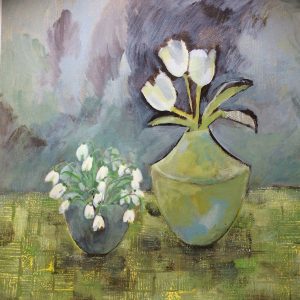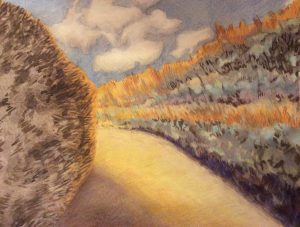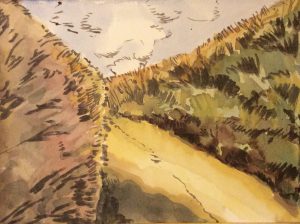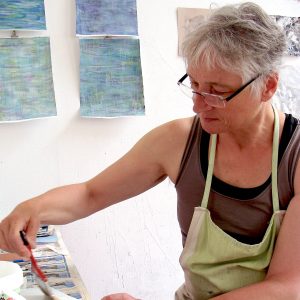Artist Residency at Hawkwood: Andrea Tierney
"Artists are making great sacrifices to finance the art they are passionate about. They work in art-related or non-art-related jobs in order to earn a living but the art they make is not financed or remunerated in any way..."

Coming from London the first impulse was to walk – walk through fields, woodland, down to the Painswick stream and up to visit the close-by villages of Painswick and Sheepscombe. The austere late-winter landscape, couched in soft fog in the mornings, coloured brighter as the day went on, gave me some brilliant views to photograph. Walking along the narrow country roads, the dense hedges, cut and shorn of all greenery, rose 2 meter-high like impenetrable borders. These naturally grown, but machinery shaped sculptures fascinated me and I attempted a number of drawings and watercolours (see attachments). I would love to revisit the area around Hawkwood again during Summer or Autumn to see how different the landscape is then.
My main aim during my stay was to write about the economic, financial and social status of artists at the present time. The Arts Council of England had commissioned a survey in 2018 with the title ‘The Livelihoods of Visual Artists in England’. This survey, together with a number of articles from art magazines and news media, formed the material I studied and on which I based a 5-page abbreviated account. During the daily meet-up with the other artists and makers staying at Hawkwood I had the opportunity to discuss my project and learn about their individual circumstances and how they made their art pay. I found that their financial situation confirmed point for point the findings from the survey.


Artists are making great sacrifices to finance the art they are passionate about. They work in art-related or non art-related jobs in order to earn a living but the art they make is not financed or remunerated in any way. Basically, artists have no regular income from their art. This leads to artists living in very precarious circumstances and without security, getting into debt and all too often unable to continue their artistic practice.
I have in the course of my writing and research come across the idea of a Universal Basic Income. This idea should be discussed in the broadest possible way and trials rolled out in all sectors of society. It could do away with the gap between rich and poor, do away with the ever more precarious nature of work, create real social security and give people self worth and self respect for what they do. It would do away with unlimited exploitation and free the potential to innovate and create. Trying to derive a living from selling one’s artwork would no longer be the way an artist is being remunerated.
My thoughts on Universal Basic Income based on a dividend are added to the researched piece on ‘The Livelihoods of Visual Artists in England’.
Since my return to London I have made contact with the Artist Union of England and sent them my written piece. Hopefully they will discuss and adopt it and campaign on the demands for a basic living wage for artists.
Original Blog Entry by Andrea Tierney. Published and Adapted by Priscila Pabon at Hawkwood CFT.
With thanks to the Francis Reckitt Art Trust, DCMS & Arts Council England for their funding that make these residencies possible. Read about our Artist Residency Programme here.
Andrea Tierney


